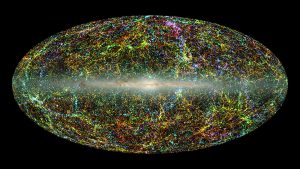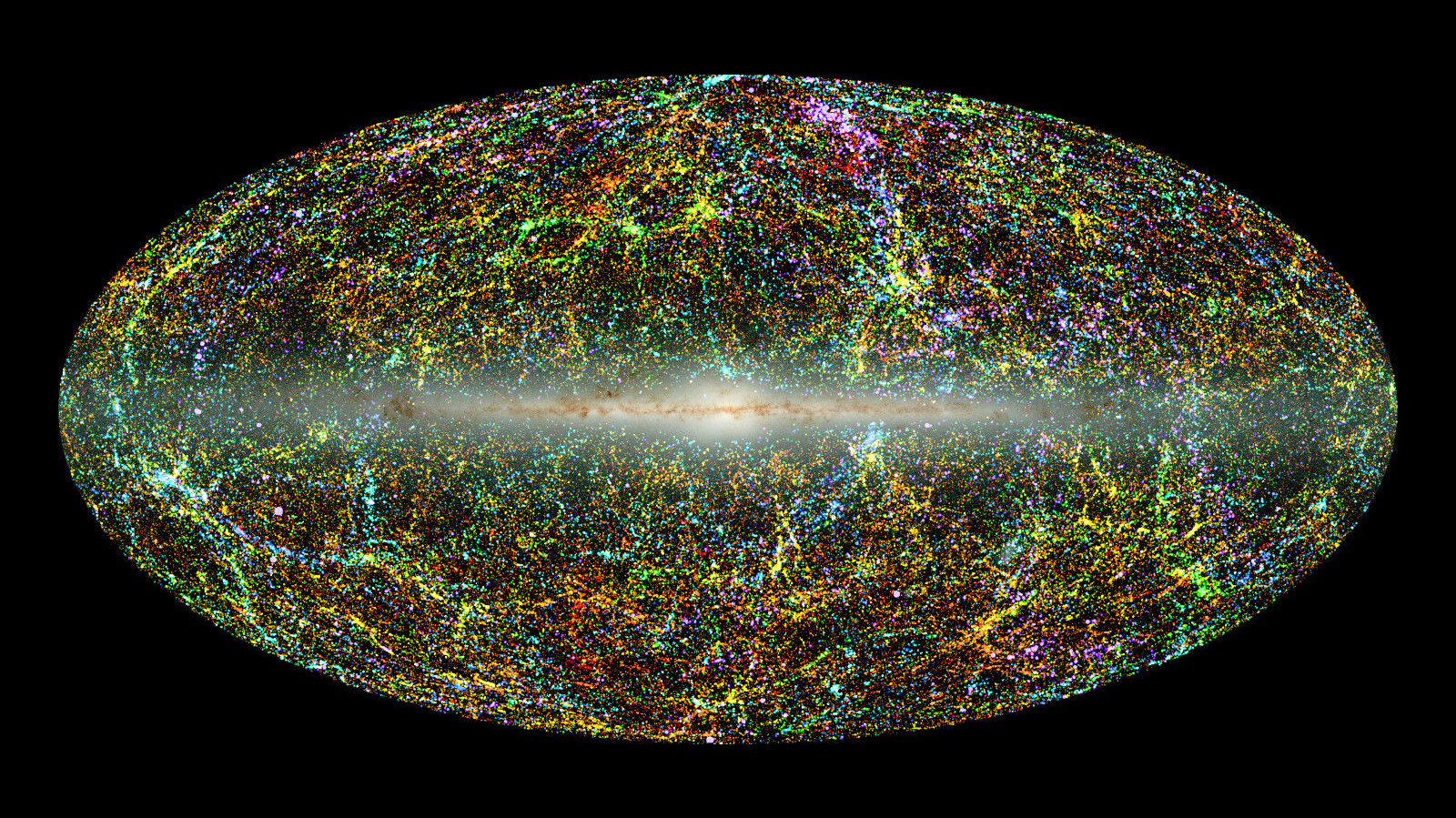Cosmologists have predicted the existence of an oscillating signal that could distinguish
between cosmic inflation and alternative theories of the universe’s birth.
The leading hypothesis about the universe’s birth — that a quantum speck of space became energized and inflated in a split second, creating a baby cosmos — solves many puzzles and fits all observations to date. Yet this “cosmic inflation” hypothesis lacks definitive proof. Telltale ripples that should have formed in the inflating spatial fabric, known as primordial gravitational waves, haven’t been detected in the geometry of the universe by the world’s most sensitive telescopes. Their absence has fueled underdog theories of cosmogenesis in recent years. And yet cosmic inflation is wriggly. In many variants of the idea, the sought-after ripples would simply be too weak to observe.
“The question is whether one can test the entire [inflation] scenario, not just specific models,” said Avi Loeb, an astrophysicist and cosmologist at Harvard University. “If there is no guillotine that can kill off some theories, then what’s the point?”
[Note from SCIET Dynamics- The “Big Bang” observations can be accounted for differently. Rather than a speck of matter, the origin was an intrusion of consciousness that expressed an energy from the center to the edge, which then defused throughout the area defined by the radius of the expression. The SCIET algorithm requires specific conditions to do this, but these conditions existed and continue to exist. This concept is not about inflation, but about consolidation within a limited space defined by the original expression. It is also necessary to dispel the idea that all the matter in the universe existed before the Big Bang, and instead embrace the idea that matter is created after the expression through the resonance of nonmaterial points with one another. This resonance continues at the heart of all matter today.]
 In a new paper that appeared on the physics preprint site, arxiv.org, on Sunday, Loeb and two Harvard colleagues, Xingang Chen and Zhong-Zhi Xianyu, suggested such a guillotine. The researchers predicted an oscillatory pattern in the distribution of matter throughout the cosmos that, if detected, could distinguish between inflation and alternative scenarios — particularly the hypothesis that the Big Bang was actually a bounce preceded by a long period of contraction.
In a new paper that appeared on the physics preprint site, arxiv.org, on Sunday, Loeb and two Harvard colleagues, Xingang Chen and Zhong-Zhi Xianyu, suggested such a guillotine. The researchers predicted an oscillatory pattern in the distribution of matter throughout the cosmos that, if detected, could distinguish between inflation and alternative scenarios — particularly the hypothesis that the Big Bang was actually a bounce preceded by a long period of contraction.
The paper has yet to be peer-reviewed, but Will Kinney, an inflationary cosmologist at the University at Buffalo and a visiting professor at Stockholm University, said “the analysis seems correct to me.” He called the proposal “a very elegant idea.”
“If the signal is real and observable, it would be very interesting,” Sean Carroll of the California Institute of Technology said in an email.
Any potential hints about the Big Bang are worth looking for, but the main question, according to experts, is whether the putative oscillatory pattern will be strong enough to detect. It might not be a clear-cut guillotine as advertised.If it does exist, the signal would appear in density variations across the universe. Imagine taking a giant ice cream scoop to the sky and counting how many galaxies wind up inside. Do this many times all over the cosmos, and you’ll find that the number of scooped-up galaxies will vary above or below some average. Now increase the size of your scoop. When scooping larger volumes of universe, you might find that the number of captured galaxies now varies more extremely than before. As you use progressively larger scoops, according to Chen, Loeb and Xianyu’s calculations, the amplitude of matter density variations should oscillate between more and less extreme as you move up the scales. “What we showed,” Loeb explained, is that from the form of these oscillations, “you can tell if the universe was expanding or contracting when the density perturbations were produced” — reflecting an inflationary or bounce cosmology, respectively.
Regardless of which theory of cosmogenesis is correct, cosmologists believe that the density variations observed throughout the cosmos today were almost certainly seeded by random ripples in quantum fields that existed long ago.
Because of quantum uncertainty, any quantum field that filled the primordial universe would have fluctuated with ripples of all different wavelengths. Periodically, waves of a certain wavelength would have constructively interfered, forming peaks — or equivalently, concentrations of particles. These concentrations later grew into the matter density variations seen on different scales in the cosmos today.
But what caused the peaks at a particular wavelength to get frozen into the universe when they did? According to the new paper, the timing depended on whether the peaks formed while the universe was exponentially expanding, as in inflation models, or while it was slowly contracting, as in bounce models.
If the universe contracted in the lead-up to a bounce, ripples in the quantum fields would have been squeezed. At some point the observable universe would have contracted to a size smaller than ripples of a certain wavelength, like a violin whose resonant cavity is too small to produce the sounds of a cello. When the too-large ripples disappeared, whatever peaks, or concentrations of particles, existed at that scale at that moment would have been “frozen” into the universe. As the observable universe shrank further, ripples at progressively smaller and smaller scales would have vanished, freezing in as density variations. Ripples of some sizes might have been constructively interfering at the critical moment, producing peak density variations on that scale, whereas slightly shorter ripples that disappeared a moment later might have frozen out of phase. These are the oscillations between high and low density variations that Chen, Loeb and Xianyu argue should theoretically show up as you change the size of your galaxy ice cream scoop.
These oscillations would also arise if instead the universe experienced a period of rapid inflation. In that case, as it grew bigger and bigger, it would have been able to fit quantum ripples with ever larger wavelengths. Density variations would have been imprinted on the universe at each scale at the moment that ripples of that size were able to form.The authors argue that a qualitative difference between the forms of oscillations in the two scenarios will reveal which one occurred. In both cases, it was as if the quantum field put tick marks on a piece of tape as it rushed past — representing the expanding or contracting universe. If space were expanding exponentially, as in inflation, the tick marks imprinted on the universe by the field would have grown farther and farther apart. If the universe contracted, the tick marks should have become closer and closer together as a function of scale. Thus Chen, Loeb and Xianyu argue that the changing separation between the peaks in density variations as a function of scale should reveal the universe’s evolutionary history. “We can finally see whether the primordial universe was actually expanding or contracting, and whether it did it inflationarily fast or extremely slowly,” Chen said.

Exactly what the oscillatory signal might look like, and how strong it might be, depend on the unknown nature of the quantum fields that might have created it. Discovering such a signal would tell us about those primordial cosmic ingredients. As for whether the putative signal will show up at all in future galaxy surveys, “the good news,” according to Kinney, is that the signal is probably “much, much easier to detect” than other searched-for signals called “non-gaussianities”: triangles and other geometric arrangements of matter in the sky that would also verify and reveal details of inflation. The bad news, though, “is that the strength and the form of the signal depend on a lot of things you don’t know,” Kinney said, such as constants whose values might be zero, and it’s entirely possible that “there will be no detectable signal.”

